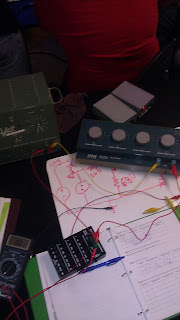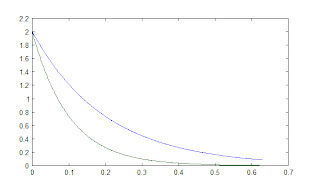The theoretical Values for Voltage and Power at the potentiometer are
V=2.26
P=.234
| Voltage 0 |
Resistance 0 |
Power 0 |
| 0.15 | 0.21 | 0.03 |
| 0.3 | 0.42 | 0.05 |
| 0.46 | 0.69 | 0.08 |
| 0.61 | 0.95 | 0.1 |
| 0.92 | 1.59 | 0.13 |
| 1.22 | 2.46 | 0.15 |
| 1.48 | 2.72 | 0.2 |
| 1.75 | 3.54 | 0.22 |
| 2.22 | 5.39 | 0.23 |
| 2.25 | 5.56 | 0.23 |
| 2.39 | 6.29 | 0.23 |
| 2.52 | 7.02 | 0.23 |
| 2.63 | 7.8 | 0.22 |
| 2.74 | 8.58 | 0.22 |
I am having trouble pasting my graphs into the blog from excel. The measure of potentiometer resistance that results in max power transfer is 5.56 ohms the theoretical value of resistance is 5.50 ohms, which yields a max power of .234, so percentage error is 1.7% which is an acceptable value! Theoretical Values Measured Values R1=.987 KohmsR2=9.970 KohmsR3=9.959 KohmsR4=.989 KohmsR5=.998 Kohms 4.5V=4.479V=8.89
From the picture it is hard to tell but the Highest power input is at , , which is when the Load resistance from the potentiometer is equal to the Thevinin resistance,Therefore we can conclude that max power transfer will always occur when these two values are equal to one another.



















